Purple oxalis: features and rules of care
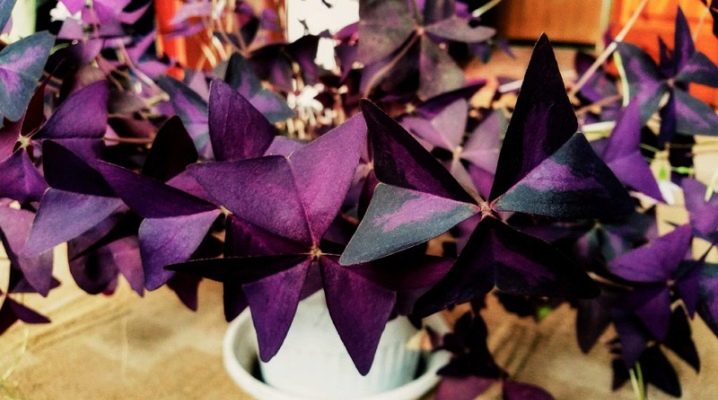
Violet oxalis is a beautiful, unpretentious plant, which is why gardeners around the world love to grow it indoors and outdoors. There are over eight hundred species of this plant. Moreover, it is customary to call it differently: hare cabbage, flower of happiness, sour clover. The main scientific name is Oxalis Triangularis.

general description
Violet oxalis looks extremely original both in the room on the windowsill and on the street flower bed. In a cloudy sky, the leaves on its flowers close, resembling butterflies. In daylight, oxalis pleases with lush flowering, strewn with bright flowers among unusual triangular leaves.
It is because of the ternary foliage shape that the plant is still heard as triangular oxalis. The shrub is undersized and does not exceed 25 cm in height. The leaves have different shades, the pigment of which depends equally on the variety and the conditions of its cultivation.
Adequate lighting gives them a rich, deep color, and lack of light leads to fading.

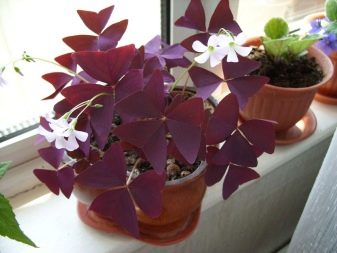
The unusual shrub Triangularis is in bloom all summer long. Flowers have a unique shape and structure. Inflorescences come in a variety of colors, from white and yellow to all shades of pink and purple. On the territory of Russia, violet oxalis is most common. The plant smells fragrant, and its purple leaves taste sour. Therefore, it bears its name and serves not only as a decorative decoration for interiors, but also as a substitute for green sorrel in cooking.


Such plant species are also widespread.
- Reverse triangular oxalis with an unusual shape of leaves and flowers. Green leaves with pointed edges look very unusual. The geometric shape attracts gardeners and florists who collect oxalis to their cultivation.

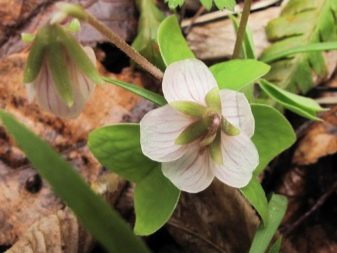
- "Depp" or four-leaf oxalis - a variety suitable for home cultivation and planting in street beds. Delicate olive leaves are four-lobed with a burgundy core. Against such a background, bright scarlet flowers look contrasting and spectacular. In Europe, this variety is known as the "lucky clover".

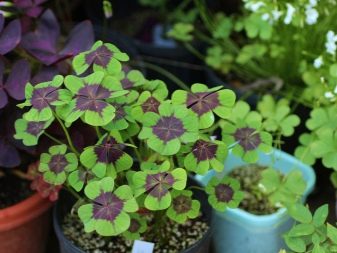
- Multi-colored oxalis - a variety of incredible beauty, very popular because of the peculiar color of the flowers - snow-white in rich red stripes.

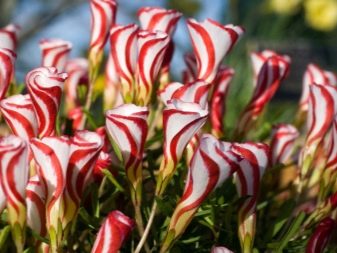
Care rules
It is easy to take care of acidic acid at home if you follow a few basic steps. They include a standard three-step approach: watering, feeding, replanting. Since the plant is considered gentle, regular care is necessary. If everything is done correctly, the flower will thank the owner with lush foliage in the winter season and gorgeous flowering and fragrance on summer days.
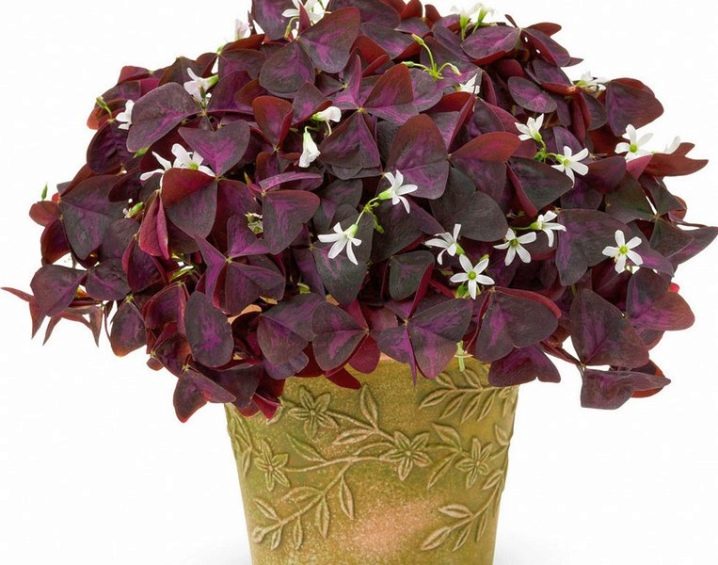
Watering
The moisture-loving flower responds well to moderate watering. It does not tolerate stagnant moisture in the soil. Water the sour cherry only when the upper soil layer is completely dry. Abundant watering is important during the growing season and during flowering. When it gets colder, the number of waterings is reduced, minimizing it. And then they stop for a while.
Indoor care involves providing the flowering culture with a resting phase. In different varieties, it differs in time frame. For some flowers, this time comes from December to January, while others need rest from October to November. There are also such varieties as "Orgtisa", which needs rest all winter.
As soon as fresh thin stems hatch, the sour cherry is immediately rearranged to a place where it is warmer (20-25 degrees) and returned to the regular watering system. Oxalis leaves favor spraying. In the summer, the plant needs to be watered with water twice a week.
The foliage becomes juicier in color and structure from moisture.


Top dressing
A plant with purple flowers at home needs feeding. Additionally, they feed the acid plant in the growing season and at the time of flowering. The houseplant loves feeding with mineral and organic substances in the form of complex fertilizers. Top dressing is carried out every couple of weeks from the beginning of spring and throughout the summer. The last feeding is at the end of August. After this, the period of preparation of violet oxalis for the resting phase begins.
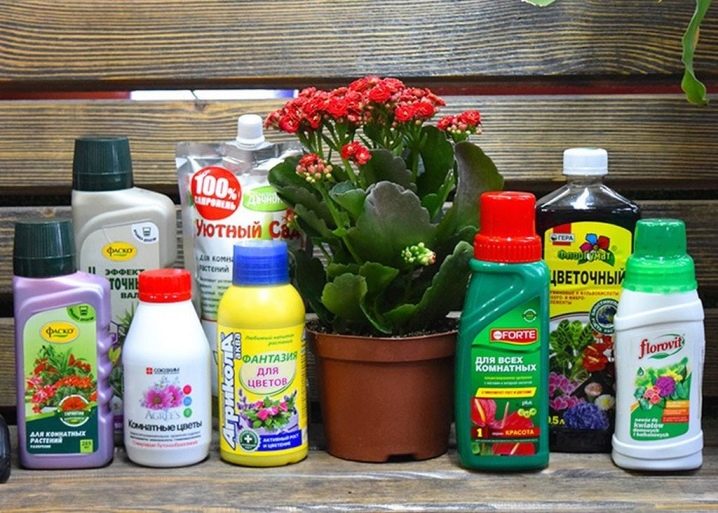
Lighting
The purple beauty loves to be in the light, but not directly under the sun. In summer, it is better to keep the pot under diffused light. The winter light will not harm the acid, because the morning sun rays in the winter season do not aggressively affect the plant. Therefore, the flower can winter on a windproof windowsill.
The most comfortable place for kislitsa is considered to be the western or eastern part of the room. Placement in partial shade is allowed, but the flower does not grow well in this case. Long-term shading makes the leaves of the flower less saturated in color.
In the garden, it is also better not to shade them with spreading crops.

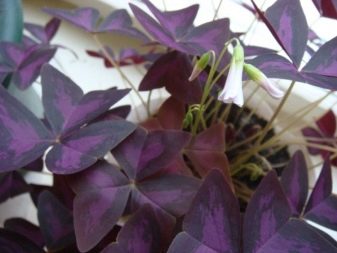
Temperature regime
For full growth and development, acid needs warmth. In spring and summer, the temperature must be maintained within + 20-25 ° C, and with cold weather, when peace is important for oxalis violet, a decrease to + 10-15 ° C is allowed. Lower temperatures will prevent the flower from developing and blooming properly.
Transfer
The overgrown lush sour cherry must be transplanted, otherwise the bush will not have enough space in the pot. Due to the constrained growth conditions, the flower will begin to lose its splendor and beauty. In order to avoid negative consequences, an annual transplant of the bushes is important.
The process begins with the preparation of the drainage, a new pot and nutrient soil.
- Pot. You need a capacity a couple of centimeters larger than the previous one, provided that the bush does not divide during the transplant. Otherwise, the old pot will do. It should have holes for fluid to drain.
- Drainage and soil. The drainage consists of small stones and river sand. The soil can be used ready-made or made from a mixture of turf and peat with sand and soil taken under the larch.
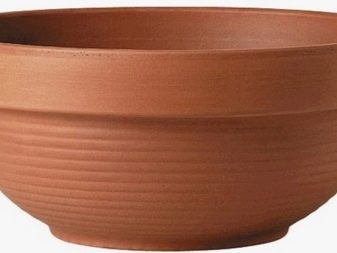
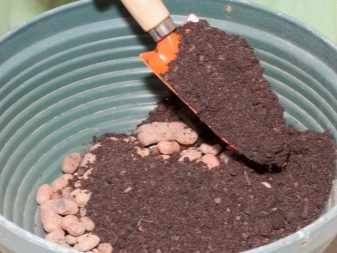
At the bottom of the prepared pot, a drainage 2 cm thick is placed, and soil is poured on top. After that, a purple acid plant is planted there. During transplantation, you need to act carefully so as not to harm the root system. Before you get the plant, the potted substrate is watered abundantly. It is advisable to leave a small layer on the roots to speed up the process of adaptation of the acid plant to new conditions.
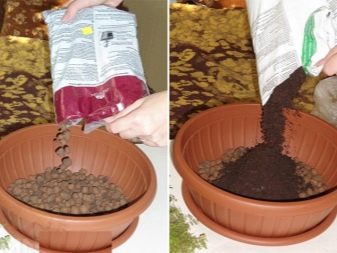

Preparing for winter
Most varieties of this ornamental crop need a dormant period of 30 days. Drying and falling leaves testify that the time has come. In the resting phase, the plant is taken to a cool room, and the number of waterings is reduced.
In some cases, foliage does not fall off the shrub, but its growth stops. This phenomenon is a signal that oxalis is preparing to winter. The end of the wintering period can be understood by the appearance of young blossoming foliage on the bush. The overwintered flower must be transplanted into a different soil and removed to a warm, sunlit room.
The previous departure is resumed.


Reproduction
Violet oxalis can be propagated in several ways:
- with bulbs;
- transplanting tubers;
- leaves and cuttings;
- dividing the bushes;
- seeds.
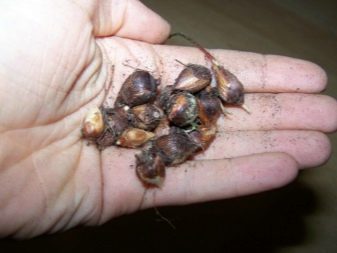

In nature, triangularis propagates by seeds, and this method is rarely used for a houseplant.Before you start growing a purple miracle from seeds, you first need to prepare the substrate. It should be nutritious, consisting of peat with the addition of deciduous humus and sand in a ratio of 4: 4: 1.
In order for the seeds to germinate faster, they need to provide good air humidity, sufficient lighting and a temperature of at least 17 degrees. Such conditions will be provided by a micro greenhouse, into which the seed is placed. From time to time it needs to be ventilated and the soil moistened. A favorable microclimate will allow the seeds to germinate in a period of 14-30 days.
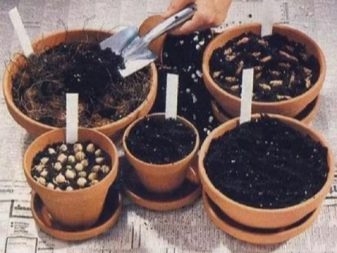
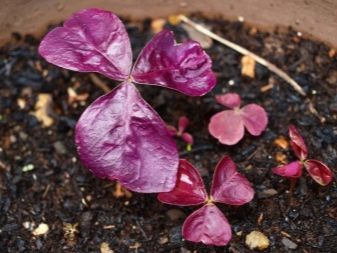
Growing new plants won't be a big deal. The plant forms many bulbs and tubers, which, when transplanted, are easy to separate and plant in individual containers. To make the bush sprawling and lush, it is wise to plant several bulbs in one flower pot.
Planting technique is identical to that for transplanted adult crops. The bulbs placed in the soil are left in a cool (15-18 ° C) and dark place. Regular watering is important for planting. With fresh seedlings, the flower is rearranged in a warm, bright place.
Another month and you can admire the young bush.
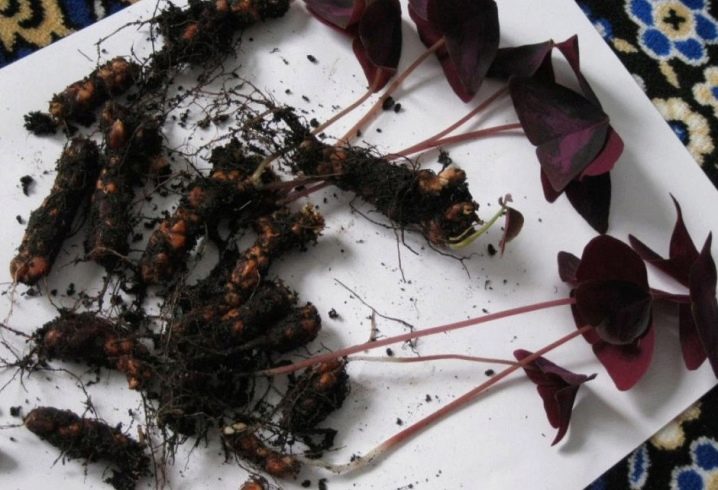
It is very easy to propagate sour cherry with cuttings and leaves. The material is placed in water in a glass. After two weeks, it is worth waiting for the appearance of root shoots. You need to wait until they grow up to 1.5 cm and plant young sour vegetables in pots.
Division of the bush. This breeding option is simple and works best with a plant transplant in the spring. To do this, carefully remove it from the pot, examining the root system for damaged and dried roots.
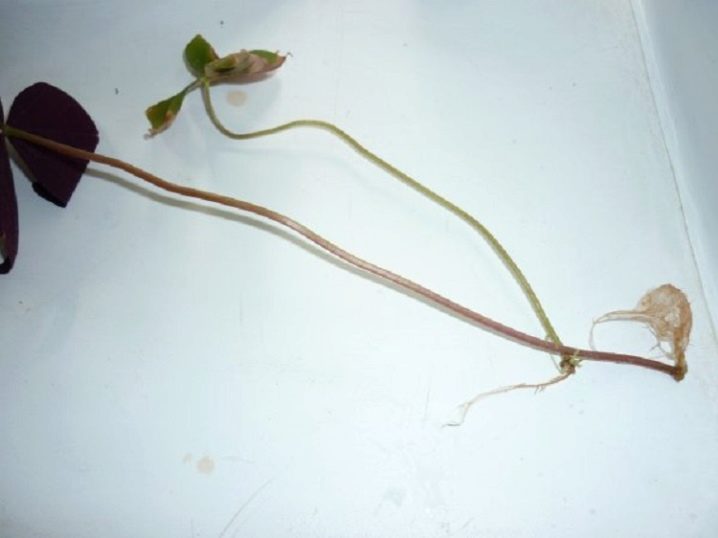
The roots are freed from the old earth and immersed in a weak solution of disinfecting potassium permanganate for several minutes. The treated mother bush is slowly divided into several seedlings. To prevent diseases, the sections are treated with brilliant green or wood ash.
The prepared parts are planted in a nutritious substrate, the pot is placed in a bright, warm room. Watering is allowed only when the topsoil dries out.
After 14 days, the transplanted acid plant will need fertilizing with mineral fertilizers.

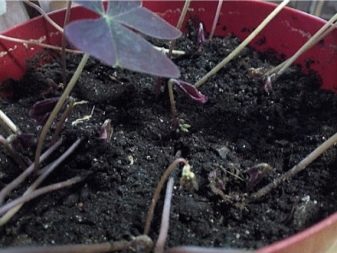
Diseases and pests
Like many domestic representatives of the flora, sour wood is attacked by insects and various diseases. Most often, the flower is inhibited by whiteflies, inhabits aphids, ticks, annoying scale insects and a small scale insect. Having found them, it is necessary to treat the plant with special preparations. They are ready-made in any flower shop.
Improper care can also damage the plant. The direct rays of the sun burn the sorrel, and the leaves wither on it. When yellow spots appear on bright triangular leaves, you must immediately react and rearrange the pot to a shaded place. Let the plant come to its senses.
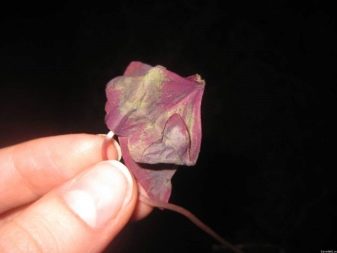
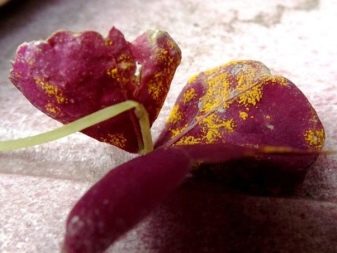
The next day, you can spray acidic water. In the future, it is better to place the flower in partial shade until the plant is completely restored.
With excessively active watering, moisture accumulates in the soil, which can lead to root rot. Leaves will react to it with loss of color and wilting. The problem will be solved by reducing the number of irrigations. The soil needs to be fluffed up and try to change its top layer. An extreme measure of flower restoration will be to transplant acid sour into a pot with a dry substrate.
In general, it is easy to care for a purple charming girl, and flower growers fully enjoy the joy for the soul from her flowering.
The main thing is to carefully observe the plant and, at the first warning signs, to take measures to save the floristic masterpiece of nature.
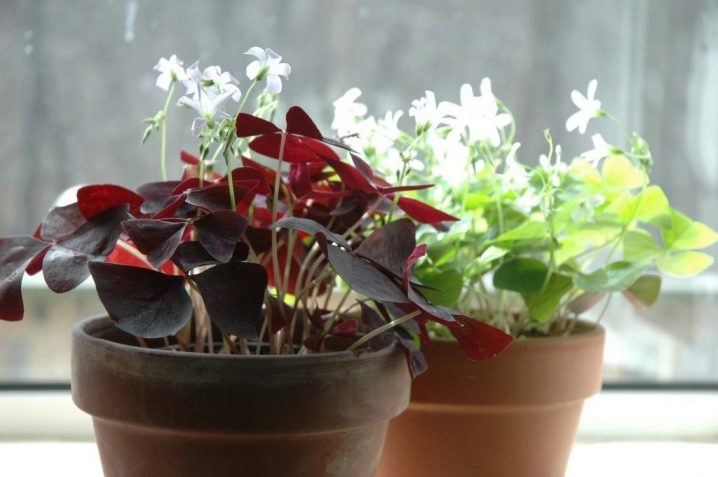
For tips on caring for purple kilitsa, see the video below.

































































































The comment was sent successfully.